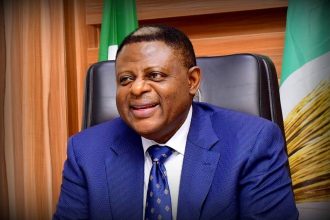After two world wars nearly destroyed the planet, at mid-century America decided to step up and apply its ingenuity to the Eastern Hemisphere’s many unstable dynamics. Europe needed settling down, then Asia, and then, later, the Middle East and Africa.
An objective view of history says that, despite our many mistakes, we’ve left each region far more stable and globally connected — not to mention wealthier — than we found them. Now, through the radical presidency of Donald Trump, we are seeking to load-shed those distant responsibilities and refocus on our own hemisphere.
If Iraq was George W. Bush’s ‘Big Bang’ theory of regional transformation, then Venezuela has become Trump’s test of hemispheric re-engineering. His administration has cast President Nicolás Maduro’s regime as the antichrist — a cauldron of corruption, narcotics, and Chinese meddling that demands and justifies a belligerent approach. To topple it, Trump vows, would be to reset the strategic physics of the Americas: a “splendid little war” for the digital age.
As unlikely as it might seem, it is a history-resuming America’s first grand strategy, part of a throughline — a connecting ideological vein — that runs from Founding Father James Monroe to William McKinley and then through Theodore Roosevelt to Trump. We are witnessing the latest iteration of an enduring American impulse: to redraw the map of the hemisphere as the world system begins to fold back upon itself.
When Monroe issued his famous doctrine in 1823, it wasn’t the chest-thumping declaration of hegemonic destiny that later generations made it out to be. The Monroe Doctrine was, at root, a nervously defensive posture — a hemispheric firewall against a reassertion of European imperial power in the post-Napoleonic world. The U.S. was barely a functioning state itself, and its military reach extended no further than its continental borders. The Doctrine’s function was more psychological bluff than strategic threat: an assertion of autonomy in a world still ruled by far more powerful empires. Monroe was drawing a line around a hemisphere — not promising dominance, merely exclusion.
Yet doctrines are like software — written for one age, they evolve and get constantly updated for another. What began as a static line of containment would, within decades, morph into an operational architecture of regional control. Expansion followed the rails of industrialization, and industrialization required order, access and secure markets. The U.S. may have rejected Old World imperialism, but it busied itself in inventing a New World variant.
McKinley, more than any president before him, gave that software a hard power upgrade. As America industrialized in the late 19th century, the Monroe Doctrine’s rhetorical simplicity became an enabling license for hemispheric integration under U.S. management. McKinley made explicit what Monroe had merely implied: that the hemisphere was not just a defensive shell but the economic flywheel for America’s industrial revolution.
Under McKinley, tariffs, territory, and communications technology (ring a bell?) were fused into a single national mission. Protectionism wasn’t a dirty word. Economic nationalism fueled industrial growth, while overseas wars — the “splendid little war” of 1898 chief among them — served both moral and mechanical functions: cleansing the neighborhood of old empires (Spain) while testing America’s new capacity for global projection. Cuba was the firewall; the Philippines were the graduation test. In those twin theaters, the United States simultaneously secured its hemisphere and previewed its emergence as a planetary actor.
McKinley’s mercantile patriotism — his oxymoronic blend of tariff walls and territorial aspiration — resonates uncannily in Trump’s own rhetoric today. The “Trump Wall of steel and tariffs” may have been marketed as an opioid of the masses, but its underlying purpose — to manufacture a protective perimeter while refocusing America inward — delivers the same sermon as McKinley’s tariff gospel. Both men saw protectionism not as retreat but readiness: a way to make America the secure base from which expansion could again proceed.
That is the part of Trumpism that much of MAGA simply does not understand and thus fearfully misinterprets.
If McKinley gave the Monroe Doctrine its mercantile teeth, Theodore Roosevelt gave it muscle and motion. His 1904 “corollary” transformed Monroe’s keep-out signage into a managerial doctrine of preemption — as in, we’ll fix it before outsiders intervene. Roosevelt wasn’t guarding a fortress; he was building a system. He used hard power (creation of the Panama Canal), soft power (the Nobel-winning peace negotiated between Japan and Russia at Portsmouth), and symbolic power (gunboat diplomacy through the deployment of the USS Maine to Havana harbor) to organize a hemisphere for the industrial century. The Roosevelt Corollary was both moral and mechanical: interventionism as hemispheric housekeeping.
Again, notice the obvious throughlines to Trump: rhetorically reclaiming the Canal, seeking a Nobel for settling Russia-vs-Ukraine, literally gun-boating Venezuela.
TR embodied America’s transition from reactive to proactive. He saw disorder not as an excuse for withdrawal, but as a call to organize — a worldview that resonates deeply with Trump’s messianic self-conception as disruptor, fixer and builder all rolled into one. Roosevelt’s expansive energy linked industrialization to order-making; Trump’s, in turn, connects digital-age reindustrialization with hemispheric control. The medium changes, but the organizing instinct endures.
Trump, now in his second term, consciously revives this lineage — Monroe’s sphere, McKinley’s tariff fortress, Roosevelt’s managerial empire — but repackages it for the 2020s. He no longer describes the Western Hemisphere as a neighborhood to protect, but as a domain to dominate. Monroe’s shield becomes Trump’s sword.
This up-tempo Monroeism isn’t about resisting foreign interference; it’s about expelling foreign presence outright. The target isn’t Europe this time, but China, whom Trump puts on notice by implicitly stating that “Here in the Western Hemisphere, we are committed to maintaining our independence from the encroachment of expansionist foreign powers.” That framing harkens back to Monroe himself, but with 21st-century tools: economic sanctions, tariff blackmail, naval shows of force and strategic investments designed to suffocate Chinese alignments in Argentina, Brazil, Peru and Venezuela.
In that sense, Trump’s Doctrine 2.0 mirrors McKinley’s operating logic: consolidate regional control to serve industrial revitalization. Energy dominance replaces steam-powered industry; reshored supply chains replace imperial trade routes. The hemisphere becomes both resource base and security zone — a closed system powering an open-ended nationalism.
Trump’s goals are not purely economic. He is Shelley’s Ozymandias personified, seeking monumentalization or visible proof of dominion. The Eastern Hemisphere, in his view, offers headaches and headlines. The Western offers trophies: infrastructure projects, resource corridors — even territorial acquisitions. The talk of annexing Greenland and militarizing the Panama Canal — dismissed by many as bluster — fits this pattern. McKinley thought in railroads and tariffs; Trump thinks in spaceports and pipelines. Both methods achieve the same end: self-actualizing national ambition.
The symbolism also matters. To Trump, the Western Hemisphere represents heritage — the space of American myth, or manifest destiny reborn. He relishes the historical echo: annexations and canal zones as hallmarks of American greatness. It is no wonder, then, that he revived “Mount McKinley” as a name, reasserting 19th-century confidence as a 21st-century brand.
‘Florida Man’s’ hemispheric vision even has a headquarters: Miami. In the Trumpian worldview — aided and abetted by his Cuban American Secretary of State Marco Rubio, Miami isn’t just an American city but the geopolitical capital of the Americas. From its towers of exile politics and crypto-wealth emerges what could be called the “Rubio Doctrine”: a fusion of Cold War anti-communism, migrant capitalism and regional dealmaking.
Miami connects the hemispheric network Trump aches to command — linking Cuban dissidents, Venezuelan opposition leaders, Colombian investors and regional security hawks into a single operating grid that displaces China’s Belt and Road scheme. In true Trumpian fashion, it’s a system built less on law than on leverage, less on institutions than on influence. Each transactional move — a trade deal here, an arms sale there — serves as both means and message: the return of hemispheric hierarchy. Monroe would recognize the fear; McKinley would recognize the pattern; Roosevelt would approve the ambition.
Trump’s test case, Venezuela is a gambit that is as theatrical as it is strategic. Supporting opposition leader María Corina Machado — Venezuela’s own Nobel laureate — allows Trump to root his interventionism in moral terms, even as it doubles as economic realignment (and triples as self-promotion for the 2026 Nobel). In this narrative, Venezuela isn’t just a rogue state; it’s the obstacle to an integrated Americas-First order. United hemispheric markets, linked by AI-driven supply chains, and governed by U.S. security guarantees — that’s Trump’s 21st-century version of McKinley’s tariff empire.
And the symbolism doesn’t end there. Trump, ever attuned to spectacle, has openly mused about adding new stars to Old Glory. Absurd? Not at all, because, as history shows, American grand strategy often begins with metaphors that become maps.
The key difference between Roosevelt’s century and Trump’s lies in vectoring intent: Roosevelt sought integration into the emerging East-West world system, whereas Trump seeks re-centering around an America-centered North-South world system, or one defined by superpowers’ “vertical” spheres of influence. Globalization, as implied by his calculus, dispersed power horizontally — a thousand supply chains radiating outward. Hemispheric consolidation, by contrast, is vertically efficient: energy in Texas, lithium in Bolivia, agriculture in Argentina, manufacturing in Mexico.
The grand strategic logic in turning away from East-West global integration to focusing on North-South hemispheric integration is entirely sound: East-West “globalization” has peaked, reaching its natural apogee. Now, three great production hubs/demand centers dominate the global economy: North America, Europe, and East Asia.
Each now faces more “latitudinal” issues than “longitudinal” ones. Climate change ravages the Global South and empowers the Global North, triggering pole-ward mass migrations. Demographic collapse in the North further attracts these mass migrations.
Enter Trump, to single out mass migration as the great national security threat of our age (“Your countries are going to hell”) and the resumption of our Union’s natural grand strategy is complete.
This realignment expresses what I dubbed in my 2023 book, America’s New Map, as an “Americas-First doctrine” — a pivot based not on nostalgia but on emerging structural realities. Demographics point northward, climate hardens southward, and global trade re-regionalizes vertically. The path of least resistance now runs from Alaska to Patagonia, not across oceans but within a hemisphere of shared civilization and converging markets. Trump, instinctively if not intellectually, channels that logic.
What unites Monroe, McKinley, and Trump is that recurring American order-building instinct — first territorial, then industrial, now digital. Monroe drew the perimeter. McKinley filled it. Roosevelt made it move. A century later, Trump reclaims it, portraying the Western Hemisphere as America’s natural sphere of destiny after decades of distracted globalism. In an age of disarray, Trump markets retrenchment as resurgence — the multistate Union of integration reborn as an empire of self-sufficiency.
That is the paradox at the heart of Trump’s grand strategy: nostalgic and revolutionary, insular and imperial, defensive and expansive. Like the man himself, it’s everything everywhere all at once.









